International
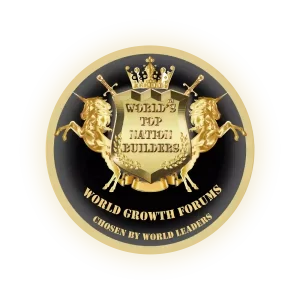
World Growth Forums Magazine June 2023
Keynote Speech by Dr Alfredo Sfeir-Younis _ WGF-GBIF Thailand 2024
What Is NATO?
Understanding Its Role Amidst the Ukraine-Russia Conflict
The ongoing conflict between Russia and Ukraine has reignited global discussions about the North Atlantic Treaty Organization (NATO) and its role in maintaining international security. With Ukraine receiving military aid from NATO members, the European defense surge, and the debate over U.S. involvement, understanding NATO’s history, purpose, and key principles is crucial.
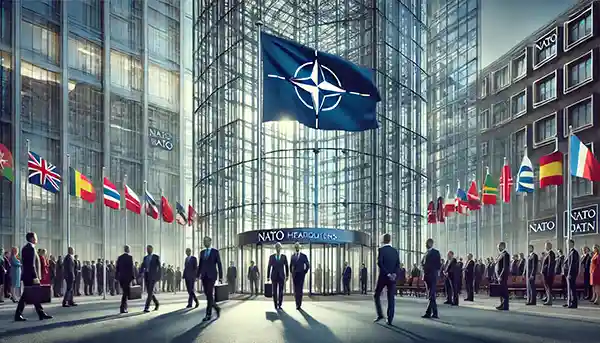
Image 1: A realistic depiction of NATO headquarters in Brussels, Belgium. The image features a modern glass building with the NATO flag waving in front, symbolizing international cooperation and security discussions.
Click Here to Know More About WGF Felicitations…
Brief History of NATO (North Atlantic Treaty Organization)
NATO was established on April 4, 1949, as a military alliance between Western nations during the Cold War. The primary purpose was to counter the influence of the Soviet Union and ensure collective security among its members.
Why Was NATO Formed?
- To prevent further wars in Europe after World War II.
- To deter Soviet expansion and aggression.
- To promote democratic values and military cooperation among allied nations.
How Does NATO Function Today?
NATO operates under a collective defense agreement, meaning an attack on one member is considered an attack on all members. The alliance engages in:
- Military training and exercises to prepare for threats.
- Joint defense strategies in case of attacks.
- Peacekeeping missions worldwide.
Which Countries Are Part of NATO?
As of 2025, NATO has 31 member states, including:
- United States, United Kingdom, France, Germany, Canada, and most European nations.
- Newest Members: Finland (joined in 2023), Sweden (approved for membership).
- Ukraine is NOT a NATO member but has expressed its desire to join.
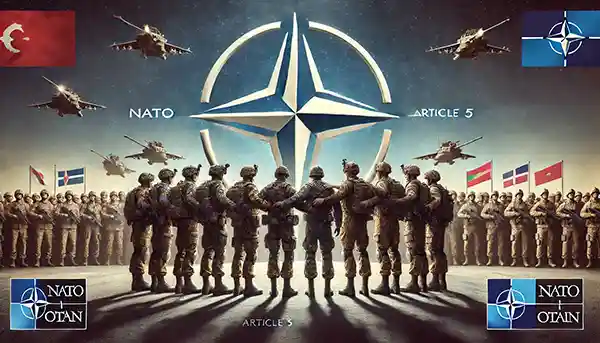
Image 2: A symbolic representation of NATO’s Article 5, showing soldiers from different NATO member countries standing together in unity. The backdrop includes the NATO emblem, emphasizing the alliance’s commitment to collective defense.
Click Here to Read What Is A Ceasefire Agreement…
What Is NATO’s Collective Defense Principle?
“An armed attack against one or more NATO members shall be considered an attack against them all.”
This ensures that if any NATO member is attacked, all allies respond collectively.
Has Article 5 Ever Been Invoked?
Yes, but only once:
- September 11, 2001: After the terrorist attacks on the U.S., NATO allies joined forces in the war on terror.
How Does Article 5 Impact Member Countries?
- Deter Aggression: Potential enemies know that an attack on one NATO country means war with all of NATO.
- Provides Military Support: NATO allies offer troops, weapons, and defense systems to protect member nations.
- Ukraine’s Dilemma: If Ukraine were a NATO member, an attack by Russia would trigger Article 5, leading to direct NATO involvement.
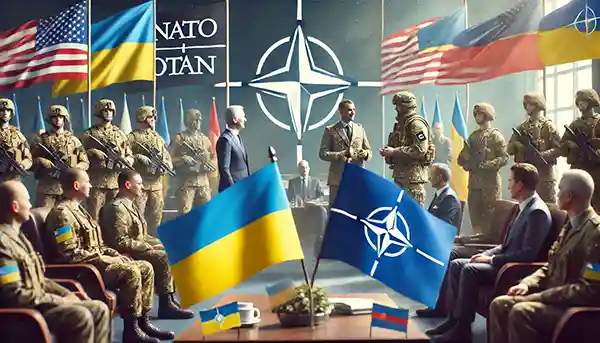
Image 3: A realistic depiction of Ukraine’s relationship with NATO. The Ukrainian and NATO flags wave side by side, symbolizing cooperation and support, while military personnel discuss strategic alliances.
Click Here to Read More under WGF What Is Series…
Why Does NATO Support Ukraine?
The ongoing conflict between Israel and Hamas has been marked by violence, casualties, and humanitarian challenges. Recently, a ceasefire was brokered, bringing temporary relief to the region.
- To prevent Russian expansion into Europe.
- To support democracy and sovereignty in Ukraine.
- To maintain regional stability and deter future conflicts.
Does Ukraine Want to Join NATO?
Yes. Ukraine has formally applied for NATO membership and has received support from Western nations. However, membership is not guaranteed due to political and security concerns.
What Are the Risks and Challenges of Ukraine’s NATO Membership?
- Risk of direct NATO-Russia conflict: If Ukraine joins NATO, Russia may escalate the war.
- Member approval required: All 31 NATO nations must agree to accept Ukraine.
- Ongoing war: NATO does not admit countries currently engaged in war, delaying Ukraine’s membership.

Image 4: A realistic depiction of the United States’ role in NATO. The image showcases the U.S. and NATO flags at an international summit, with diplomats and military officials engaged in discussions, highlighting the U.S.’s leadership in NATO decision-making.
Click Here to Read WGF Blogs from World Leaders…
How Much Does the US Contribute to NATO?
The U.S. is NATO’s largest financial and military contributor, covering:
- Over 70% of NATO’s total defense spending.
- Military bases in multiple NATO countries.
- Weapons, aircraft, and troops for NATO missions.
What Happens If the US Withdraws from NATO?
If the U.S. withdrew from NATO, it would:
- Weaken NATO’s military strength.
- Reduce funding for European defense.
- Empower Russia, as European nations may struggle to defend themselves.
How Would It Impact Global Security?
- Less Western unity → Russia and China may become more aggressive.
- Weaker European defense → EU nations would have to increase military spending.
- Increased global instability → Other countries may challenge international law.
-
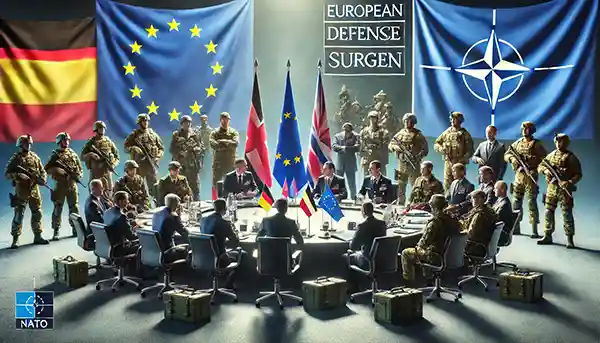
Image 5: A realistic depiction of the European Defence Surge. The image shows European military leaders and defense officials in a high-level meeting, discussing strategic military plans. EU and NATO flags are visible in the background, symbolizing increased military funding and cooperation.
Click Here to Watch Keynote Speeches and Interviews of World Leaders at WGF YouTube…
Why Are EU Leaders Increasing Military Funding?
- Growing threats from Russia.
- Uncertainty about U.S. commitment to NATO.
- Need for stronger European defense independent of the U.S.
How Is Europe Responding to US Uncertainty on NATO?
- France and Germany are leading efforts to expand EU military capabilities.
- NATO members have pledged to increase defense spending to 2% of GDP.
- Countries like Poland, Sweden, and Finland are rapidly strengthening their militaries.
What Are the Implications for Global Security?
- More military funding strengthens NATO.
- Greater EU independence could reduce reliance on the U.S.
- Tensions with Russia may increase, as Moscow sees NATO growth as a threat.
How Do French Fighter Jets Strengthen Ukraine’s Defense?
Recently, Ukraine used French fighter jets to intercept Russian attacks, marking a new phase in the war.
- Fighter jets provide air superiority, making it harder for Russia to conduct airstrikes.
- Advanced aircraft can attack enemy bases from long distances.
- French, British, and U.S. fighter jets are expected to play a bigger role in Ukraine’s defense.
What Difference Do Modern Warplanes Make in Conflicts?
- Fighter jets allow fast, precise strikes on enemy targets.
- They provide aerial cover for ground troops.
- Nations with advanced air power have a major strategic advantage.
How Does Air Superiority Affect War Outcomes?
- Countries with air superiority control the battlefield.
- Fighter jets prevent enemy bombings and destroy key targets.
- Without air support, ground troops are more vulnerable to enemy attacks.
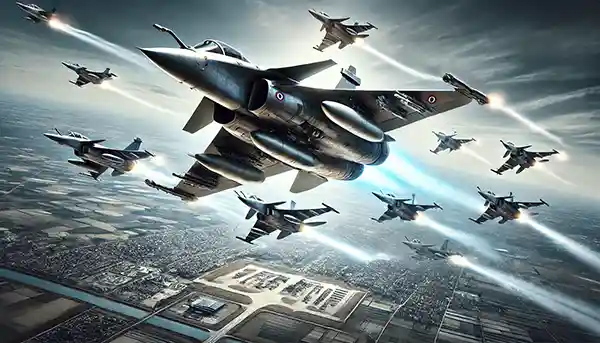
Image 6: A realistic depiction of modern fighter jets in warfare. A squadron of advanced French fighter jets is seen executing a military operation, highlighting their role in achieving air superiority and precision strikes in modern conflicts.
Click Here to Watch WGF News on World Leaders at WGF TV…
Conclusion: NATO’s Role in the Ukraine-Russia War
NATO’s presence in the Ukraine conflict highlights its importance in global security. While Ukraine is not yet a NATO member, its support from NATO countries is shaping the war.
Key Takeaways:
- NATO is a military alliance with 31 member countries.
- Article 5 ensures collective defense—an attack on one is an attack on all.
- The U.S. plays a critical role in NATO’s strength and funding.
- Europe is increasing military spending due to rising security threats.
- Fighter jets are changing modern warfare, with Ukraine using them against Russia.
As the conflict continues, NATO’s actions will influence global security for years to come.
Follow World Growth Forums on the following for more updates…

